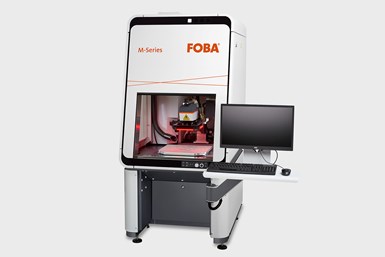Foba’s Automated M Series for Reliable Laser Marking
IMTS 2022: Foba Laser’s M series of laser marking systems are designed to overcome human error in laser marking by providing reliable, high-throughput automated systems designed to run 24/7.
Foba Laser’s M-series laser marking workstation M2000 is equipped with Foba Mosaic for precise marking. Photo Credit: Foba Laser
Foba Laser’s M series of laser marking systems feature fiber laser to provide reliable, high-throughput automated systems designed to run 24/7. The series consists of advanced, manually loaded laser marking workstations for the precise and economic processing of small, large and geometrically complex workpieces as well as small and large batches of parts.
The M series includes three systems. The M1000 is a compact, desktop laser marking machine for marking components and batches; the M2000 is a laser workstation for economical part marking and reliable traceability; while the M3000 is a laser workstation for large components and batches.
The machines feature automated marking alignment with Foba Mosaic which is said to addresse the challenge of accurately aligning marks on large parts regardless of the part position and orientation. Mosaic uses the internal camera of the laser to create an image of the marking field by simulating a straight-down camera view which is said to eliminate the side view distortion typically created when using an external camera, thereby enabling the system to accurately mark parts regardless of their placement.
The M2000 and M3000 are available in three model options — B with worktable; R with turntable; and P with axes X/Y/Z. Advanced fiber and UV laser markers are available for integration as well as fully integrated vision inspection solutions.
The general purpose B models offer a programmable Z-axis, worktable and electric lift door. The rotating high-throughput R models come with a programmable Z-axis and automated two-position rotary table. The flexible P models feature programmable axes (X, Y, Z and optionally expandable to five axes) and an electric lift door. The company says it is well suited for batch processing and small parts in trays/pallets, but also for larger parts where marking positions are outside the marking field or where marks have to be applied at several positions.
Each machine offers a small footprint, optimal accessibility and air-cooled laser systems, the company says.
Related Content
-
Tips for Troubleshooting and Repairing Chip Conveyors
A nonfunctioning chip conveyor can cause a high-production machine to be down for an extended period of time. Here is some troubleshooting advice if you’re having issues with your chip conveyors.
-
Chuck Jaws Achieve 77% Weight Reduction Through 3D Printing
Alpha Precision Group (APG) has developed an innovative workholding design for faster spindle speeds through sinter-based additive manufacturing.
-
Replace Repetitive Measurement With DIY Robotic Automation
After minimal training, a shop can learn how to use this robotic inspection system configured for a shopfloor application to supersede repetitive, time-consuming, high-mix gaging processes. It can then be redeployed for another application somewhere else in the facility.

















